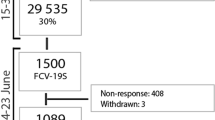Abstract
The Fear of Pain Questionnaire-III (FPQ-III) is a 30-item self-report measure designed recently to assess fears about pain across three pain dimensions: severe, minor, and medical. We conducted three studies to replicate the factor structure of the FPQ-III and examine several psychometric properties of reliability and validity in nonclinical samples. A principal-axis with oblique rotation analysis provided strong empirical support for the three-factor solution of the FPQ-III (Study 1). In Study 2, results of the confirmatory factor analyses (CFA) confirmed the fit of the three-factor oblique model to an independent sample of data. In addition, we evaluated several measurement models to address issues related to convergent and discriminant validity for the FPQ-III. In Study 3, data from adult samples were analyzed for the adequacy of internal consistency and criterion-related validity of the FPQ-III. The FPQ-III total and scales showed high levels of reliability estimates across the three studies. Limitations and future research with the FPQ-III are discussed.
Similar content being viewed by others
REFERENCES
Asmundson, G. J. G., Norton, P. J., and Norton, G. R. (1999). Beyond pain: The role of fear and avoidance in chronicity. Clin. Psychol. Rev. 19: 97–119.
Bentler, P. M., and Bonett, D. G. (1980). Significance tests and goodness-of-fit in the analysis of covariance structures. Psychol. Bull. 88: 588–606.
Bentler, P. M., and Wu, E. J. C. (1997). EQS Structural Equations Program, Version 5.6, Multivariate Software, Encino, CA.
Browne, M. W., and Cudeck, R. (1992). Alternative ways of assessing model fit. Sociol. Meth. Res. 21: 230–258. Fear of Pain Questionnaire 173
Gil, K. M., Williams, D. A., Keefe, F. J., and Beckham, J. C. (1990). The relationship of negative thoughts to pain and psychological distress. Behav. Ther. 21: 349–362.
Gorsuch, R. L. (1991). UniMult Guide, UniMult, Altandena, CA.
Gorsuch, R. L. (1983). Factor Analysis, 2nd ed., Lawrence Erlbaum, Hillsdale, NJ.
Hursey, K. G., and Jacks, S. D. (1992). Fear of pain in recurrent headache sufferers. Headache 32: 283–286.
Kabacoff, R. I., Segal, D. L., Hersen, M., and vanHasselt, V. B. (1997). Psychometric properties and diagnostic utility of the Beck Anxiety Inventory and the State-Trait Inventory with older adult psychiatric outpatients. J. Anx. Dis. 11: 33–47.
Keogh, E., and Reidy, J. (2000). Exploring the factor structure of the Mood and Anxiety Symptom Questionnaire (MASQ). J. Person. Assess. 74: 106–125.
Larsen, D. K., Taylor, S, and Asmundson, G. J.G. (1997). Exploratory factor analysis of the Pain Anxiety Symptom Scale in patients with chronic pain complaints. Pain 69: 27–34.
Lubin, B. (1994). State Trait-Depression Adjective Check Lists: ST-DACL (Form F), Psychological Assessment Resources, Odessa, FL.
McCracken, L. M., Zayfert, C., and Gross, R. T. (1992). The Pain Anxiety Symptoms Scale (PASS): Development and validation of a scale to measure fear of pain. Pain 50: 67–73.
McNeil, D. W., and Rainwater, A. J., III (1998). Development of the Fear of Pain Questionnaire-III. J. Behav. Med. 21: 389–410.
Oei, T. P. S., Evans, L., and Cook, C. M. (1990). Utility and validity of the State Trait Anxiety Inventory with anxiety disorder patients. Br. J. Clin. Psychol. 29: 429–432.
Osman, A., Bunger, S., Osman, J. R., and Fisher, L. (1993). The Inventory of Negative Thoughts in Response to Pain: Factor structure and psychometric properties in a college sample. J. Behav. Med. 16: 219–224.
Osman, A., Barrios, F. X., Osman, J. R., Schneekloth, R., and Troutman, J. A. (1994). The Pain Anxiety Symptoms Scale: Psychometric properties in a community sample. J. Behav. Med. 17: 511–522.
Osman, A., Barrios, F. X., Gutierrez, P. M., Kopper, B. A., Merrifield, T., and Grittmann, L. (2000). The Pain Catastrophizing Scale: Further psychometric evaluation with adult samples. J. Behav. Med. 23: 351–365.
Satorra, A., and Bentler, P. M. (1994). Corrections to test statistics and standard errors in covariance structure analysis. In Van Eye, A., and Clogg, C. C. (eds.), Latent Variable Analysis: Applications for Developmental Research, Sage, Thousand Oaks, CA, pp. 399–519.
Spielberger, C.D., Gorsuch, R. C., and Lushene, R. E. (1983). Manual for the State-Trait Anxiety Inventory (Form Y), Consulting Psychologists, Palo Alto, CA.
Sullivan, M.J. L., Bishop, S.C., and Pivik, J. (1995).The Pain Catastrophizing Scale: Development and validation. Psychol. Assess. 7: 524–532.
Turk, D. C., and Rudy, T. E. (1992). Cognitive factors and persistent pain: A glimpse into Pandora's Box. Cognit. Ther. Res. 16: 99–122.
Velicer, W. F. (1976). Determining the number of components from the matrix of partial correlations. Psychometrika 41: 321–327.
Watson, D., and Clark, L. A. (1991). The Mood and Anxiety Symptom Questionnaire (MASQ). Unpublished manuscript, University of Iowa, Iowa City.
Watson, D., Clark, L. A., Weber, K., Assenheimer, J. S., Strauss, M. E., and McCormick, R. A. (1995a). Testing a tripartite model. II. Exploring the symptom structure of anxiety and depression in students, adult and patient samples. J. Abnorm. Psychol. 104: 15–25.
Watson, D., Weber, K., Assenheimer, J. S., Clark, L. A., Strauss, M. E., and McCormick, R. A. (1995b). Testing a tripartite model. I. Evaluating the convergent and discriminant validity of anxiety and depression symptom scales. J. Abnorm. Psychol. 104: 3–14.
Wheaton, B., Muthen, B., Alwin, D. F., and Summers, G. F. (1977). Assessing reliability and stability in panel models. In Heise, D. R. (ed.), Sociological Methodology, Jossey-Bass, San Francisco, CA.
Zwick, W. R., and Velicer, W. F. (1986). Comparison of five rules for determining the number of components to retain. Psychol. Bull. 99: 432–442.
Author information
Authors and Affiliations
Corresponding author
Rights and permissions
About this article
Cite this article
Osman, A., Breitenstein, J.L., Barrios, F.X. et al. The Fear of Pain Questionnaire-III: Further Reliability and Validity with Nonclinical Samples. J Behav Med 25, 155–173 (2002). https://doi.org/10.1023/A:1014884704974
Issue Date:
DOI: https://doi.org/10.1023/A:1014884704974




